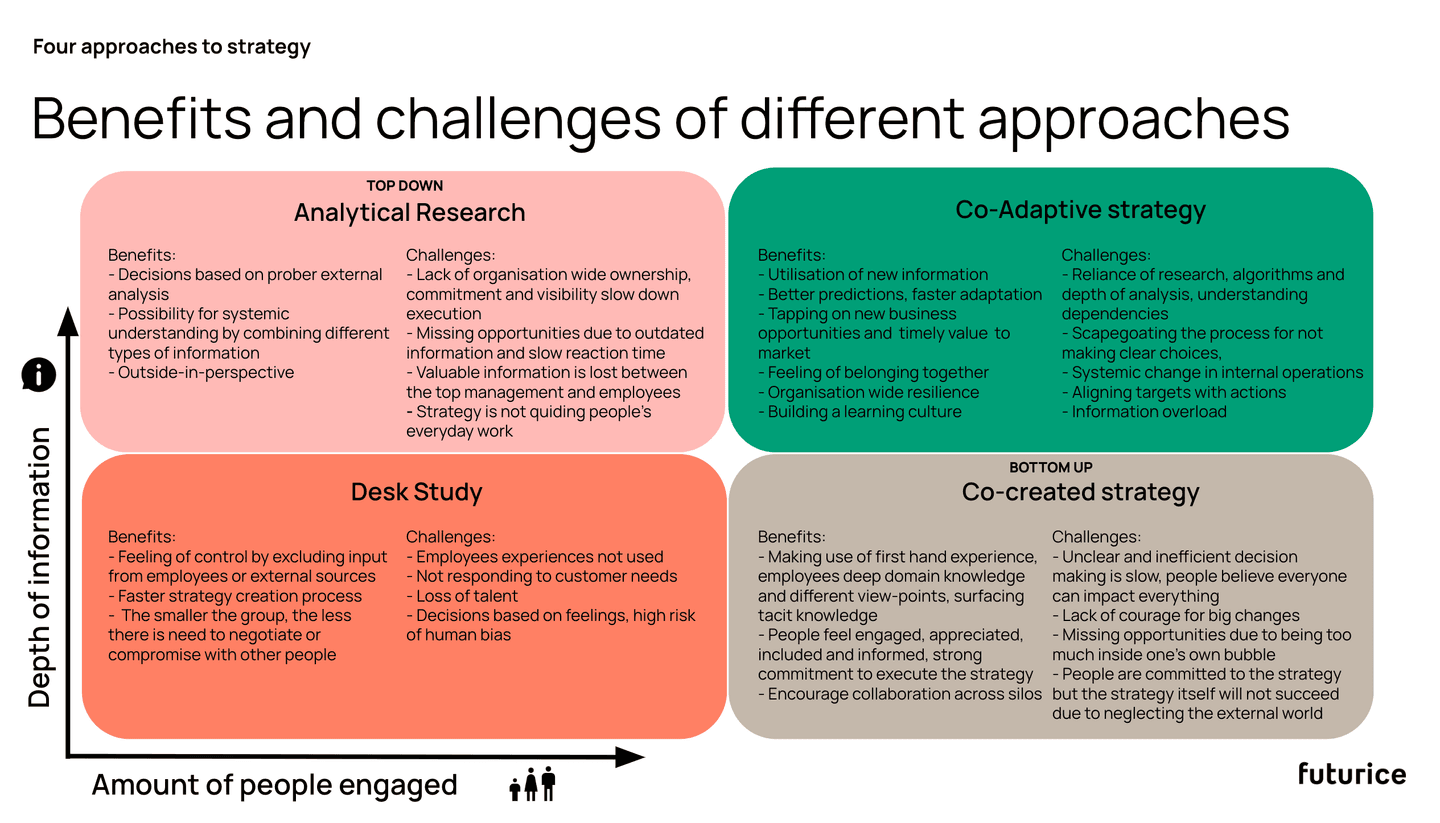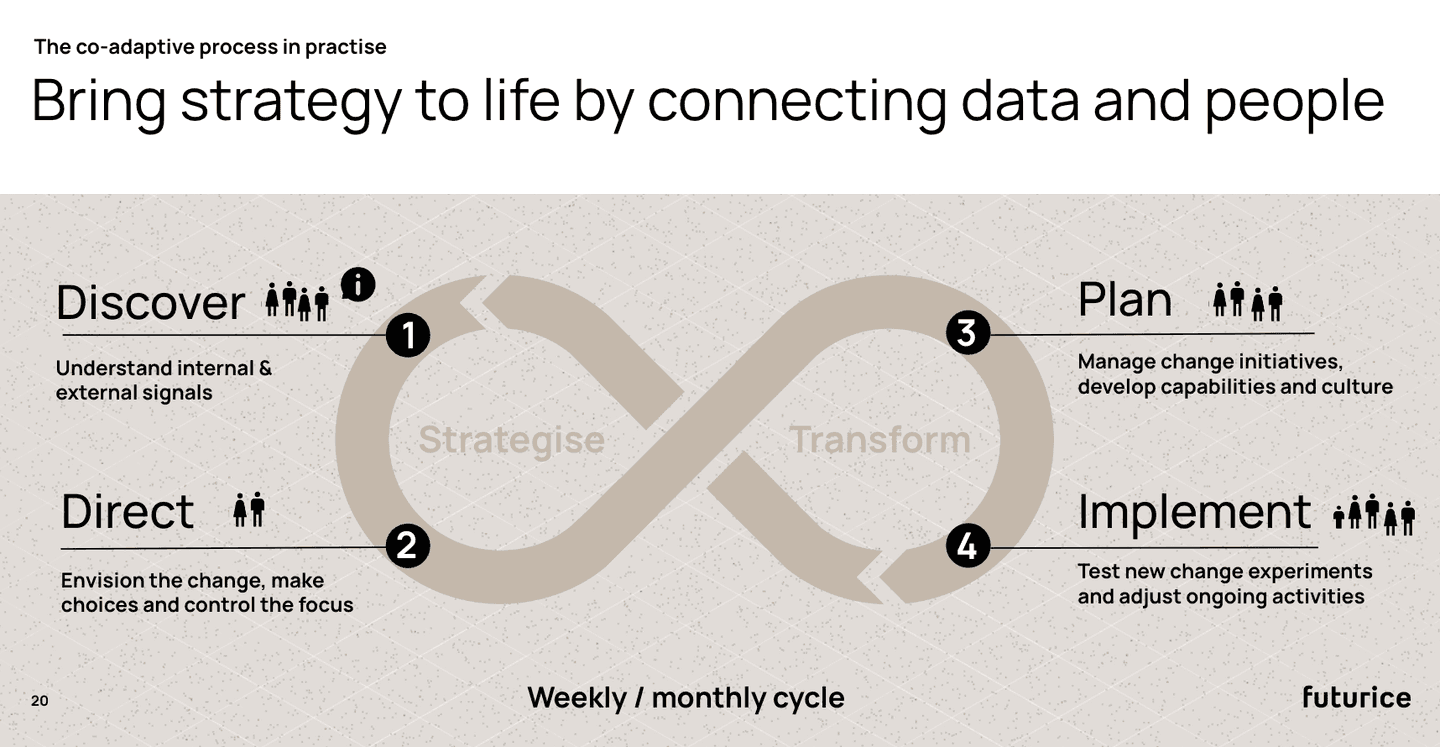Focus on the right things faster with co-adaptive strategy
Your competitive advantage is temporary. New competitors and business opportunities will emerge sooner than you expect. Most companies are experiencing high volatility in demand and profitability. In our uncertain and complex world, you’ll need to respond to changes faster than ever. This calls for a co-adaptive approach to strategy that connects data and people. In this article I’ll explain what it is, and how you can build your adaptation capabilities.

Connect data and people
Today’s business success is not made with the best strategy – instead, it is enabled by the fastest implementation and adaptation. This requires real-time information and appropriately timed decisions.
At Futurice, we’ve recognised that relying solely on “relevant data” is not enough. You cannot afford to miss the first-hand experiences of your frontline employees, as they have valuable insights. The true value of gathering information from different sources is only created through dialogue with people. And people need to be engaged and empowered to act in time. We call this approach co-adaptive strategy. How is it different from what you might be used to?
Is your current approach to strategy outdated?
There are three traditional approaches to forming and executing a strategy, whether it is a business, product or sales strategy.
1. Desk study
“Carpenters should focus on their work, not strategy.”
In this approach, only one or few individuals do the strategic thinking, and they might not even share the strategy with their employees. Strategy is executed by defining roles for people and telling them what they need to do.
2. Analytical research
“We formulate a strategy and then hope for the best.”
In this top-down approach, the strategy is created by a small group of directors, often with the help of external consultants who have strong domain expertise to conduct research.
3 Co-created strategy
“We believe (only) in our own employees.”
A bottom-up approach where the strategy is crafted together with employees, as well as key clients and stakeholders. Facilitators get people to discuss choices and decisions together. This approach is sometimes also referred to as open strategy
The most typical of these approaches – analytical research – worked well in the past when the world was more predictable and corporations were more analog than today. Now, digitalization and data are transforming all organizations. This also creates a need for organizations to rethink strategy processes, and the forerunners are already doing that.
The shift toward data-enabled co-creation in strategy
In addition to the three traditional approaches, there is a fourth one: co-adaptive strategy. It is a data-enabled and co-created strategy process that is all about having constant dialogue, experimenting and scaling what works.
We call this approach co-adaptive because a constant stream of data alone isn’t enough – you’ll need collaboration and engagement as well. The big difference to the traditional approaches is that in this approach, strategy formulation and execution are not two separated phases but a constant loop. The co-adaptive approach runs at a much faster clock speed.

The value of co-adaptive strategy lies in speeding up learning – testing hypotheses about markets and customer needs, experimenting to find out what works, and so on. Early failures are valuable. The transformation doesn’t just apply to a few projects, it’s about building a culture of constant improvement and data-enabled adjustment, and establishing a growth mindset across the whole organization.
Previously it was important that a company strategy is based on gaining sustainable competitive advantage, differentiating from the competition. Long term north star is still needed, but how to get there can not be fixed for the next five years.
Don’t fight against change, embrace it: a co-adaptive strategy process enables faster execution and adaptation by connecting data and people.
Lean startups already create and test their strategic hypotheses at a fast pace in order to find the right focus for growing their business. But adopting a co-adaptive approach to strategy also offers huge opportunities to larger corporations.

What does a co-adaptive approach to strategy look like in practice?
The co-adaptive strategy process comprises four stages. Each of them comes with tasks that are done on a weekly or monthly basis, as well as things that are done at a much slower pace, e.g. yearly. This approach scales all the way from the corporate strategy level down to executing individual strategic streams in a co-adaptive way.
- The discovery stage is about capturing internal and external change signals, doing analysis and making predictions, and sharing learnings. This is where you gain data about the success of your experiments and visibility on their progress.
- The direction stage is about clarifying the vision and ambition, where to go, and fine-tuning your targets and metrics. At this stage you make high-level decisions between alternatives, figure out how to get there, and establish a budget – which has to be flexible.
- The planning stage is about planning and managing the entire portfolio of your change initiatives. This is where you make concrete plans on how to develop your culture, competences, systems, structures, ways of working, products, sales and marketing.
- The implementation stage is about practical change experiments, adjusting your ongoing activities and scaling up what works. You’ll need a culture of constant learning and courage to validate new ideas with customers before they are fine-tuned into perfect concepts.
How to get started?
The exact process of adopting a co-adaptive approach to strategy varies slightly between unique organizational contexts, but the broad outline is this:
- Understand the obstacles and possibilities related to being more adaptive – ask your own people for their point-of-view.
- Choose an area where to pilot the co-adaptive approach.
- Study what kind of information is important and available to you to improve data-enabled decision-making in that chosen pilot area. Turn business problems into data questions. Gather and analyse data, experiment with alternative data sources.
- Establish who needs to be involved in co-adaptive strategy and why, and how you plan to engage them (e.g. through surveys, interviews, focus groups, discussion forums, workshops, co-creating materials asynchronously).
- Create your first plan on how to pilot data-driven and participatory ways of working to apply co-adaptive strategy process in practice. How will you apply the four stages and which topics will be covered and in which time frame.
- Gather evidence of what works and what doesn’t, learn and improve your practices as a part of applying the co-adaptive strategy process.
Futurice can help you get started by assessing your co-adaptive capabilities – that is, how co-adaptive your culture is, what your data maturity level is, and what opportunities there are to make your strategy implementation more effective.
Interested in learning more? Follow us! In the next blog articles I’ll share more insights on how to connect people and data, and how to improve your co-adaptation capabilities.
To discuss further on this, write to me at piritta.vanderbeek@futurice.com
 Piritta van der BeekPrincipal Advisor
Piritta van der BeekPrincipal Advisor






